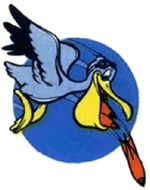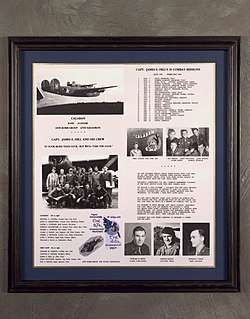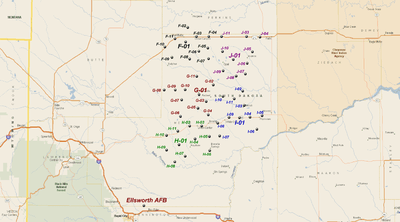67th Missile Squadron
The 67th Missile Squadron is an inactive United States Air Force unit. It was last assigned to the 44th Operations Group, stationed at Ellsworth AFB, South Dakota.
| 67th Missile Squadron | |
|---|---|
 LGM-30F Minuteman II test launch at Vandenburg AFB, California | |
| Active | 1940-1946; 1947-1948; 1950-1960; 1962-1993 |
| Country | |
| Branch | |
| Type | Squadron |
| Role | Intercontinental ballistic missile |
| Engagements | World War II (American Campaign) (EAME Theater) |
| Decorations | Distinguished Unit Citation (2x) Air Force Outstanding Unit Award |
| Insignia | |
| 67th Strategic Missile Squadron emblem | |
| 67th Bombardment Squadron emblem (approved 12 July 1943)[1] |  |
The 67 MS was equipped with the LGM-30F Minuteman II Intercontinental ballistic missile (ICBM), with a mission of nuclear deterrence. With the end of the Cold War, the 67th was inactivated on 15 August 1992.
History
World War II
Established in early 1941 as a B-24 Liberator heavy bombardment squadron, it trained under the Third Air Force in the southeastern United States. After the Pearl Harbor Attack, it engaged in anti-submarine patrols over the Gulf of Mexico.
Deployed to the European Theater of Operations (ETO), it was assigned to the Eighth Air Force (VIII Bomber Command) in England during the summer of 1942. One of the first B-24 Liberator units assigned to the ETO, the squadron was engaged in very long range strategic bombardment missions over Occupied Europe and Nazi Germany, attacking strategic targets in France, Belgium, the Netherlands and Germany. Among the targets attacked were submarine installations, industrial establishments, airfields, harbors and shipyards.
A detachment deployed to the Ninth Air Force in Algeria in June 1943 to help facilitate the Allied invasion of Sicily by bombing airfields and marshalling yards in Italy. The detachment also participated in the low-level raid on the Ploiești oil fields in Romania on 1 August 1943. Most of the detachment returned to England at the end of August, however some crews and aircraft remained in the Mediterranean Theater of Operations (MTO) and flew very long range attacks over Italy, Romania, Austria and Sicily and supported Allied ground forces in Sicily as well as attacking Axis forces in Italy. The squadron also supported the Salerno landing. All aircraft and personnel returned to England in October. Example: Missions of Capt. James E. Hill and his 10-man B-24 crew in 1943:

The squadron returned to VIII Bomber Command operations and supported the Allied Invasion of France in June 1944 by attacking strongpoints in the beachhead area and transportation targets behind the front line. The group aided the Caen offensive and the Saint-Lô breakthrough in July. It dropped food, ammunition and other supplies to troops engaged in the airborne attack on the Netherlands in September. It attacked enemy targets during the Battle of the Bulge between December 1944 and January 1945, by striking bridges, tunnels, rail and road junctions and communications in the battle area. The squadron attacked airfields and transportation in support of the Western Allied Invasion of Germany, and flew a resupply mission during the airborne assault across the Rhine in March 1945. Combat operations concluded with the German capitulation in May 1945.
The unit returned to the United States in June 1945, being reassigned to the Second Air Force and re-designated as a B-29 Superfortress 'Very Heavy' bombardment squadron. It trained with B-29s and planned to deploy to the Western Pacific, however the Japanese capitulation in August canceled these plans. It was assigned to Kansas as part of the Continental Air Forces, (later Strategic Air Command or SAC), but it was inactivated in July 1946 as part of the general demobilization of the AAF.
Strategic Air Command
Reactivated in 1947 under SAC as a paper unit, it was not manned or equipped and was inactivated in 1949 due to budget constraints.
It was re-activated in 1950 and used as an Operational Training Unit for B-29 aircrews and maintenance personnel being deployed to the Far East Air Forces during the Korean War. The propeller-driven B-29s were replaced with new B-47E Stratojet swept-wing medium bombers in 1953. These aircraft were capable of flying at high subsonic speeds and primarily designed for penetrating the airspace of the Soviet Union.
The B-47 was considered to be reaching obsolescence in the late 1950s and were being phased out of SAC's strategic arsenal. The squadron began sending aircraft to other B-47 wings as replacements in late 1959, before being phased down for inactivation in 1960.
Intercontinental Ballistic Missile Squadron
The unit was re-activated in 1962 as a SAC ICBM missile squadron. It trained with the 850th SMS in HGM-25A Titan I operations in 1962 and became operational with LGM-30B Minuteman I missiles in 1963. It upgraded to the LGM-30F Minuteman II in 1972. The squadron remained on Cold War nuclear alert until President Bush's directive to stand the Minuteman II down. Dissipated launch codes and pin safety control switches at 15 launch control facilities. Deactivation of the entire missile complex ended in the summer of 1992, the squadron inactivated on 15 August.
Lineage
- Constituted as the 67th Bombardment Squadron (Heavy) on 20 Nov 1940
- Activated on 15 Jan 1941
- Re-designated the 67th Bombardment Squadron (Very Heavy) on 5 Aug 1945
- Inactivated on 12 Jul 1946
- Activated on 1 Jul 1947
- Inactivated on 6 Sep 1948
- Re-designated the 67th Bombardment Squadron (Medium) on 20 Dec 1950
- Activated on 2 Jan 1951
- Discontinued on 15 Jun 1960
- Re-designated the 67th Strategic Missile Squadron on 19 Mar 1962
- Organized on 1 Sep 1962
- Re-designated the 67th Missile Squadron on 1 Sep 1991
- Inactivated on 15 Aug 1992
Assignments
- 44th Bombardment Group, 15 Jan 1941 – 12 Jul 1946; 1 Jul 1947-6 Sep 1948; 2 Jan 1951
- 44th Bombardment Wing, 16 Jun 1952
- Department of the Air Force, 15 Jun 1960
- Strategic Air Command, 19 Mar 1962
- 44th Strategic Missile Wing, 1 Sep 1962
- 44th Operations Group, 1 Sep 1991 – 15 Aug 1992
Stations
|
|
Aircraft and missiles

- B-24 Liberator, 1941–1945
- TB-29 Superfortress, 1951; B-29 Superfortress, 1945–1946; 1947–1948; 1951–1952
- B-47 Stratojet, 1953–1960
- LGM-30B Minuteman I, 1963–1973
- LGM-30F Minuteman II, 1972–1992
67th Missile Squadron Launch Facilities
- Missile Alert Facilities (F-J flights, each controlling 10 missiles) are located as follows:
- F-01 61.0 mi NxNE of Ellsworth AFB, SD. 44°59′49″N 102°45′43″W
- G-01 11.3 mi N of Union Center SD, 44°43′25″N 102°39′00″W
- H-01 10.0 mi SW of Union Center SD, 44°27′43″N 102°48′55″W
- I-01 5.7 mi E of White Owl SD, 44°36′10″N 102°18′57″W
- J-01 13.8 mi SE of Maurine SD, 44°54′20″N 102°21′55″W
References
![]()
- Maurer, Combat Squadrons, pp. 250-251
- Maurer, Maurer, ed. (1983) [1961]. Air Force Combat Units of World War II (PDF) (reprint ed.). Washington, DC: Office of Air Force History. ISBN 0-912799-02-1. LCCN 61060979.
- Maurer, Maurer, ed. (1982) [1969]. Combat Squadrons of the Air Force, World War II (PDF) (reprint ed.). Washington, DC: Office of Air Force History. ISBN 0-405-12194-6. LCCN 70605402. OCLC 72556.
- Ellsworth AFB Minuteman Missile Site Coordinates

